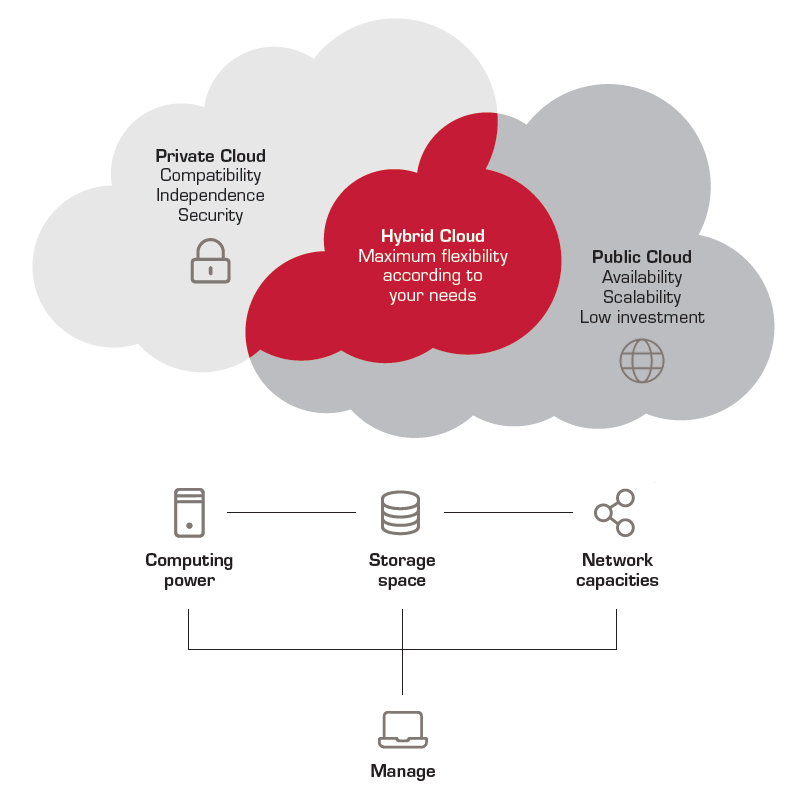What Is a Hybrid Cloud?

The hybrid cloud describes a demand-oriented combination of private and public cloud environments, which combine the advantages of the different concepts: on premise or external private cloud (run by a Managed Service Provider) with a public cloud.
The hybrid cloud concept depends on the company’s requirements but a key fundamental surely is a seamless integration of applications and services. Such an agile infrastructure clearly provides competitive advantages and opens up potential savings. For many companies, the hybrid cloud represents an ideal bridging solution to switch to a cloud strategy step by step.
General Structure of a Hybrid Cloud
In general, a hybrid cloud architecture comprises an existing private cloud in a “traditional” data center, one or more public clouds and one or more external clouds, operated in a Managed Service Provider’s data center. It is imperative to setup the integration as seamless as possible between the different clouds to ensure a smooth migration, interoperability, and uniform administration.
Where the different IT services are located within the model is entirely up to the respective company:
- For example, a company can decide that all sensitive information should remain on premise and only non-critical one should be stored on cloud servers.
- Another possibility is to leave the complete data storage in the company and just use the computing power of an external cloud.
- Sometimes the other way around is exactly the right one: While the computing power is provided on site, all data is on cloud storage.
Just these three possibilities give an idea of how flexible a hybrid cloud concept can be.

Public Cloud: Pros and Cons
With a so-called public cloud, companies use parts of a publicly accessible data center and its services. IT applications are rented from an external provider and employees access applications and/or services by using a frontend (graphical user interface, GUI), Internet Browser or via API.
Computing power, storage space, network capacities and hardware such as routers, switches or firewalls can be used as possible services (Infrastructure-as-a-Service, IaaS). Development environments for web applications can be created (Platform-as-a-Service, PaaS) and browser-based access to software can be granted (Software-as-a-Service, SaaS). Well-known public cloud providers are Amazon Web Services (AWS), Microsoft Azure and Google Cloud Platform (GCP).
Benefits of the Public Cloud:
- Guaranteed availability of the services thanks to globally distributed data centers and corresponding security measures from cloud providers
- Almost limitless scalability, as the payment is based on the actual use of resources (“pay-as-you-go”), adjustable any time as required, like in case of season-based order peaks
- Low investment costs, because a state-of-the-art data center is available externally, so customers do not have to invest in upgrading their own infrastructure
Potential Downsides of the Public Cloud:
- Data security might be a concern if the storage location is not fixed through contracts
- Also, usage within a multi-tenant environment can create uncertainty as the infrastructure must be shared with other customers who are usually unknown
- Options for individualization can be limited for some customer demands due to the
standardized (hardware) infrastructure, provisioned for too many users - Business continuity risks can arise if business-critical systems fail and the high availability concept does not consider the use of multiple availability zones (locations)
Private Cloud: Pros and Cons
The desire for control, security and for individualization drives companies to operate their cloud-computing environment themselves. They want to ensure services run exclusively on a dedicated private IT environment and are available to authorized employees only. Common synonyms for the private cloud are also “corporate cloud” or “internal cloud”.
The private cloud can be technically implemented by virtualizing the existing IT infrastructure and make these cloud services accessible either via the company’s internal network or via appropriately encrypted public networks (Virtual Private Network, VPN). Depending on the size and complexity of the organization, running the company’s own data center (internal private cloud) might be the second-best solution compared to working with external partners (hosted private cloud).
Benefits of the Private Cloud:
- High efficiency due to the compatibility with existing systems and the possibility of adding new systems and tailor-made services based on individual needs and requirements
- Independence from third parties and full control regarding access to the private cloud services
- Maximum influence on security and data protection setup and rules
- Considerable savings potential compared to conventional IT infrastructures by higher utilization of hardware and server environment
Potential Downsides of the Private Cloud:
- More administrative work for internal IT and less time for developing innovations
- New technologies like Internet of Things (IoT) or Machine Learning (ML) must be self-implemented and maintained
- Delivering latest security standards needs dedicated products, services, and resources
- Higher costs for infrastructure, implementation and maintenance compared to a public cloud
- Harder to keep up to date with the latest data protection standards such as the EU General Data Protection Regulation (GDPR)
- Potential security risks or leaks if security tools and settings are not at highest standards
Hybrid Cloud: Pros and Cons

The hybrid cloud describes a setup where cloud platform and services, made available by public cloud providers, integrate as seamless as possible with an internal/private cloud. Depending on requirements, which, after all, change over time, workloads and/or data can be moved flexibly between the various cloud units.
Unlike so-called multi-cloud approaches, in which each cloud environment is usually managed separately, the hybrid cloud is supposed to be managed by a single management platform.
The challenge, though, is to neatly separate the various business applications or processes. This becomes even more challenging when you have to consider whether they are data protection critical.
Implementing a hybrid cloud demands a solid concept, not only from a technological point of view, but also from the perspective of application and service availability as well as data processing and protection.
Benefits of the Hybrid Cloud:
- Well-designed hybrid clouds basically combine the best of a private and public cloud
- Maximum flexibility through the combination of private and public cloud
- Easy increase of compute power to cover demand-based peaks
- On-demand use of public cloud services helps to keep costs under control
- Freedom of choice to use private or public cloud services for dedicated workloads
- Considerable savings potential through elasticity and “on demand” usage concept
Potential Downsides of the Hybrid Cloud:
- Possibly higher costs if redundancy between cloud models is not avoided or eliminated
- Potentially higher initial conceptual and implementation efforts due to a comprehensive IT and business process analysis, which should lead to a clear usage concept
- Complexity can be significantly higher, and it can increase the workload on IT resources
if no automation and management tool is implemented or used
Who Should Consider a Hybrid Cloud as the Right Choice?
When comparing the pros and cons of the different cloud concepts, it becomes obvious: The key argument for choosing a hybrid approach is its flexibility. Whether an organization should go for a hybrid cloud or not depends on various factors, including: What strategic goals does the company have set for the near- and medium-term future? What regulations is it possibly subject to? And how high is the degree of standardization of the various processes and applications?
Basically, it can be said that the hybrid cloud is a good choice for organizations that …
- need a flexible cloud structure they can adapt to their dynamic workloads
- must process large amounts of data, e. g. for business intelligence (BI) analysis
- use temporary applications or want to introduce new ones quickly
- are subject to very strict legal and data protection regulations but still want to make use of the flexible public cloud resources and services
- operate globally and do not want to run private clouds or data centers at every site
- do not want to rush anything and prefer to gradually migrate workloads to the cloud
Application Scenarios for the Hybrid Cloud
Due to its high flexibility, the hybrid cloud is suitable for a variety of use cases, for example:
Variable or Increasing Workload
Business applications develop dynamically. To be prepared for increasing workloads, it is advisable to operate services with changing or growing workloads in the public cloud. More stable,
constant or data sensitive workloads (e. g. core value-processes in production) might be rather suitable for a private cloud or even on premise-based operation.
 Processing of Big Data
Processing of Big Data
When a company runs big data analysis, the exact volume might be difficult to predict. The solution could be to rely on the quickly scalable resources of the public cloud and keep confidential or highly sensitive information (e.g. for payroll) in the private cloud at the same time.
Temporary or New Applications
If an application is only used temporarily or if something new is to be tried out, the hybrid cloud approach enables the flexible allocation of public cloud resources without having to commit in advance or invest in devices that may only be required for a short period of time.
Legal Regulations
Some industries have always been subject to strict data protection terms. Since the introduction of the General Data Protection Regulation (GDPR) in the European Union, almost every company is affected. Global players, which have to deal with regulations in other parts of the world, benefit from a hybrid cloud strategy in which data can be distributed between private and public environments.
Gradual Move to the Cloud
If a company has not yet used a public cloud, a gradual move is an option with a view on personnel and costs, as well as risk minimization. For example, a small private cloud can be set up for sensitive applications and some defined workloads can be shifted to the public cloud. Additional public cloud resources and services can be connected as needed to increase agility.
Safety Aspects to Be Considered
With a hybrid cloud, companies generally feel to have more control over security compared to “just” using public clouds, because they can choose where to store confidential information or run sensitive applications. The number of interfaces is ideally kept as low as possible to avoid unnecessary security risks or to increase complexity. Where useful, however, a secure interoperation via container technology or encrypted API interfaces could be a good option.
Overall, the advantages of a hybrid cloud strategy also come into play for security because companies benefit from an IT architecture that is set up separately and networked at the same time. This reduces the risk of data leaks and at the same time the cloud structure can be flexibly expanded as required.
Now, How Do You Embark on the Path of a Hybrid Cloud?
The complexity of IT environments is constantly increasing, and cloud structures even add to that. Undoubtedly, IT departments feel the enormous expectations of demanding business units to deliver state-of-the-art solutions and services on highest security standards without compromising on usage comfort. This ultimately leads to prioritization of projects or sometimes no innovations at all.
A reliable partner with decades of experience, not only with SAP solutions, but also with the operation of first-class, highly automated data centers around the world, can take some pressure off your IT teams by contributing with innovations and experiences from other hybrid cloud projects. And that can only be of benefit for your company.
At NTT DATA Business Solutions, we not only run hundreds of customer environments in our private clouds, but also combine public cloud services with either our, your or any other cloud as well as on premise environment. Feel free to challenge us and let us help you design a tailor-made hybrid cloud concept for you!
Check the Complexity of your IT Now
Learn more about our Managed Cloud Services